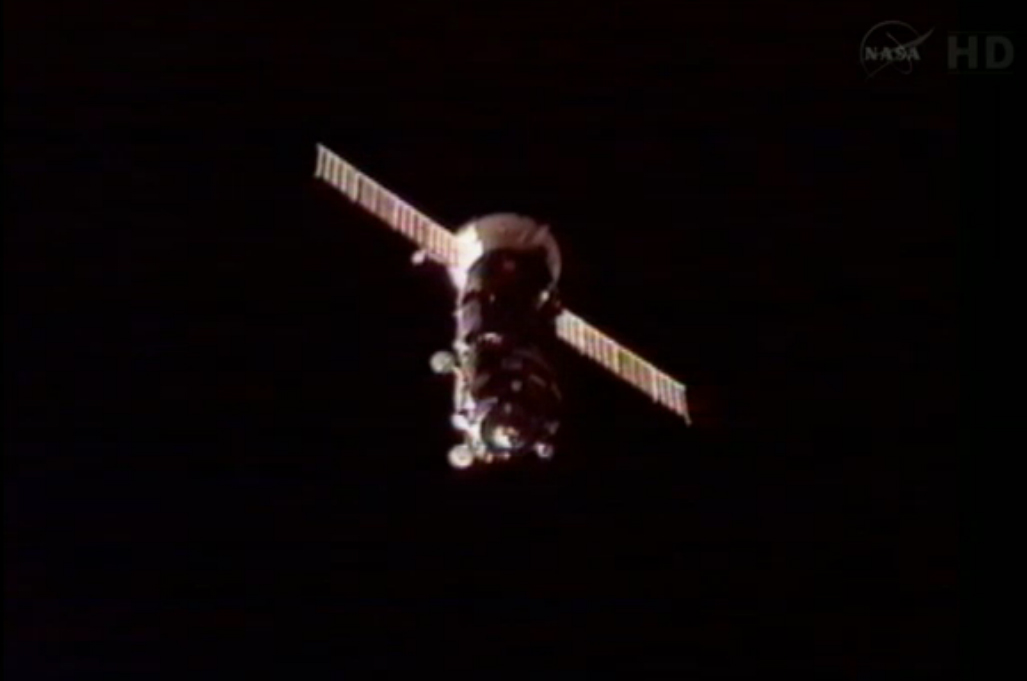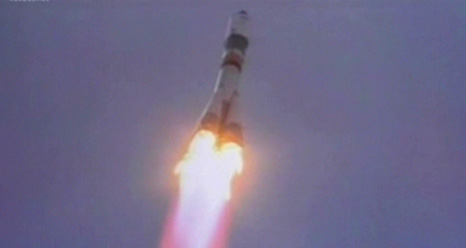Russian Robotic Supply Ship Docks at Space Station

An unmanned Russian supply ship arrived at the International Space Station Sunday (April 22) carrying tons of fresh supplies in an Earth Day delivery for the orbiting lab's crew.
The robotic Progress 47 cargo ship docked with the space station at 10:39 a.m. EDT (1439 GMT), ending a two-day flight that began with an eye-catching launch. The two spacecraft were sailing 249 miles (400 kilometers) over northern China, just south of the Mongolia border, when Progress 47 parked itself at the orbiting lab.
"Congratulations on a successful automatic docking," flight controllers in Russia's Mission Control Center in Moscow radioed the station crew in Russian.
The Progress supply ship is filled with more than 2.8 tons of food, equipment and other gear for the six-man crew living aboard the space station. Its arrival, which occurred on Earth Day by coincidence, comes just days after the departure of its predecessor Progress 46 from the station, and a week before the much-anticipated launch the first private U.S. cargo ship to the orbiting lab — the robotic Dragon capsule built by California-based SpaceX. Dragon is slated to launch on April 30.

With the retirement of NASA's space shuttle fleet last year, the space agency is dependent on Russia's Progress vehicles and similar robotic space trucks launched by Japan and Europe to ferry its supplies to the station. The Dragon capsule will be the first of two private U.S. spacecraft to take on the job with it begins operational flights.
Russia's Progress space cargo trucks are similar in appearance to the three-module Soyuz vehicles used to ferry crews to and from the International Space Station. Both vehicles have a propulsion module and orbital module, but the progress carries a fuel-laden module for the station's thrusters in place of the central crew capsule used on Soyuz flights. [How Russia's Progress Spaceships Work (Infographic)]
Progress 47 is filled with vital supplies for the space station's Expedition 30 crew, which includes three Russians, two Americans and one Dutch astronaut. The supply ship is carrying about 110 pounds (50 kilograms) of oxygen and air, 926 (420 kg) pounds of water, 1,988 (901 kg) pounds of propellant and 2703 pounds (1,226 kg) of dry supplies such as food, spare parts and experiment gear.
Get the Space.com Newsletter
Breaking space news, the latest updates on rocket launches, skywatching events and more!
The arrival of Progress 47 comes at a busy time for the International Space Station. On Friday (April 27), three station crewmembers will return to Earth to wrap up their months-long mission. NASA astronaut Daniel Burbank, the station's Expedition 30 commander, and cosmonauts Anton Shkaplerov and Anatoly Ivanishin are expected to return home aboard a Soyuz space capsule and land on the steppes of Kazakhstan in Central Asia.
Then comes the anticipated Dragon launch, which if all goes well, will occur on April 30 and be followed by a rendezvous at the space station a few days later. Astronauts aboard the station will use the outpost's robotic arm to grapple the Dragon capsule and attach to an empty port.
Three new space station crewmembers are slated to launch aboard a Soyuz spacecraft on May 17.
You can follow SPACE.com Managing Editor Tariq Malik on Twitter @tariqjmalik. Follow SPACE.com for the latest in space science and exploration news on Twitter @Spacedotcom and on Facebook.
Join our Space Forums to keep talking space on the latest missions, night sky and more! And if you have a news tip, correction or comment, let us know at: community@space.com.

Tariq is the Editor-in-Chief of Space.com and joined the team in 2001, first as an intern and staff writer, and later as an editor. He covers human spaceflight, exploration and space science, as well as skywatching and entertainment. He became Space.com's Managing Editor in 2009 and Editor-in-Chief in 2019. Before joining Space.com, Tariq was a staff reporter for The Los Angeles Times covering education and city beats in La Habra, Fullerton and Huntington Beach. In October 2022, Tariq received the Harry Kolcum Award for excellence in space reporting from the National Space Club Florida Committee. He is also an Eagle Scout (yes, he has the Space Exploration merit badge) and went to Space Camp four times as a kid and a fifth time as an adult. He has journalism degrees from the University of Southern California and New York University. You can find Tariq at Space.com and as the co-host to the This Week In Space podcast with space historian Rod Pyle on the TWiT network. To see his latest project, you can follow Tariq on Twitter @tariqjmalik.









